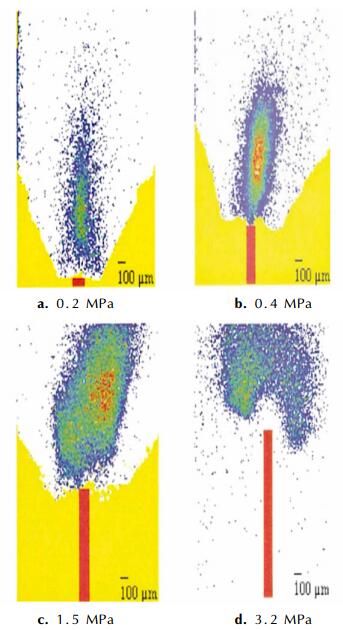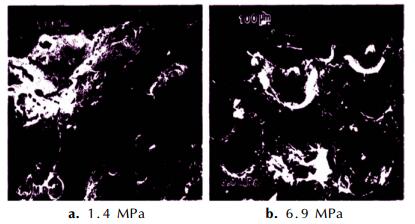高氯酸铵/端羟基聚丁二烯 (AP/HTPB) 是一种典型的复合固体推进剂, 由氧化剂AP颗粒和粘合剂HTPB混合而成, 其燃烧特性和火焰结构依赖于燃烧压力和材料非均匀性质。针对AP/HTPB的燃烧特性, 前人做了诸多工作, Price等[1]通过扫描电镜 (SEM) 观察发现, AP/HTPB在微观尺度上呈准周期性排列, 结构表现为三明治分布, 因此可以将AP/HTPB复合推进剂宏观燃烧简化为微观三明治单元燃烧。Chorpening[2]利用紫外线透射成像技术观测了不同压力下推进剂燃烧表面上方的火焰结构。Beckstead等[3]对AP/HTPB复合推进剂表面结构进行了大量实验观测后, 提出了BDP多火焰模型, 能合理地解释推进剂的诸多燃烧特征。Bilger等[4]以Pe数或雷诺数形式研究了推进剂燃烧时对流和扩散在方程和边界条件中应用的重要性。Buckmaster[5]和Jackson[6]采用总包气相反应建立了二维和三维几何模型, 对推进剂燃烧的火焰结构进行了模拟, 进一步支持了Bilger的研究成果。Hegab等[7]研究了AP/HTPB复合固体推进剂燃烧气相与固相间的耦合问题。Cai[8]分析了AP颗粒尺寸、环境压力和气相反应速率等参数对推进剂燃烧气相火焰结构的影响。Jackson[9]建立了AP颗粒随机分布的三维非定常模型并进行了数值模拟。叶锐和曹永杰[10-11]以Pe数为基础, 讨论了不同工况下侧向速度等参数对燃烧的影响。AP/HTPB复合固体推进剂燃烧火焰可以看作是由大量的微尺度火焰单元组成, 研究单个火焰单元的燃烧特性, 有助于从宏观上深入了解其燃烧机理和性能。
为了进一步研究AP/HTPB微观单元的燃烧特性和火焰结构, 本研究基于气相火焰与固相推进剂的耦合, 利用计算流体动力学 (CFD) 方法, 从流动燃烧角度, 采用简化的两步总包化学反应动力学机理, 基于BDP多火焰模型, 建立了二维周期性三明治定常燃烧模型, 借助FLUENT软件, 数值分析了AP体积分数一定 (0.75) 时, 不同燃烧压力下的燃烧参数分布特性以及氧化剂含量 (0.7 < α < 0.95) 对燃烧的影响。
2 物理模型针对本文采用的AP/HTPB二维微尺度周期性三明治燃烧模型, 如图 1所示, 作如下简化假设:
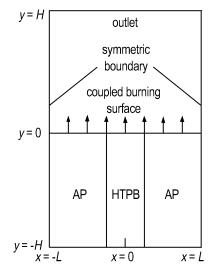
|
图 1 AP/HTPB微尺度燃烧模型 Fig.1 Microscale combustion model of AP/HTPB |
(1) 燃气为不可压理想气体, 气相各组分Lewis数均为1;
(2) 固相热分解和气相反应均满足Arrhenius定律;
(3) 固相分解仅发生在燃面层, 通过质量、能量通量平衡以及温度连续性关系耦合气固两相;
(4) 不考虑燃气辐射及燃面形状;
(5) 以源项法描述固相热分解及气相扩散燃烧。
3 数学模型根据上述物理模型, 建立低雷诺数下二维定常流动燃烧基本控制方程, 具体如下:
3.1 气相控制方程(1) 质量守恒方程
| $ \nabla \cdot \left( {{\rho _{\rm{g}}}\mathit{\boldsymbol{u}}} \right) = 0 $ | (1) |
(2) 动量守恒方程
| $ \frac{\partial }{{\partial {x_k}}}\left( {{\rho _{\rm{g}}}{u_j}{u_k}} \right) = \frac{\partial }{{\partial {x_k}}}\left( {{\mu _{\rm{g}}}\frac{{\partial {u_j}}}{{\partial {X_k}}}} \right) - \frac{{\partial p}}{{\partial {x_j}}} + {S_j} $ | (2) |
(3) 组分守恒方程
| $ {\rho _{\rm{g}}}\mathit{\boldsymbol{u}} \cdot \nabla {Y_i} = \nabla \cdot \left( {\frac{{{\lambda _{\rm{g}}}}}{{{c_p}Le}}\nabla {Y_i}} \right) + {S_{{Y_i}}} $ | (3) |
(4) 能量守恒方程
| $ {\rho _{\rm{g}}}{c_p}\mathit{\boldsymbol{u}} \cdot \nabla T = \nabla \cdot \left( {{\lambda _{\rm{g}}}\nabla T} \right) + {S_{\rm{T}}} $ | (4) |
(1) 式~(4) 式中, u为速度矢量, m·s-1; uj和uk为速度张量,j和k指标范围是 (1, 2);ρg为气相密度, kg·m-3; μg为气相粘性系数, N·s·m-2; λg为气相导热系数, W·m-1·K-1; cp为气相的定压比热容, J·kg-1·K-1; Yi为气相组分i的质量分数; Le为无量纲Lewis数, Sj为气相动量源项, N·m-3; SYi为气相组分源项, 为无量纲; ST为气相能量源项, W·m-3。
3.2 固相能量方程| $ {\rho _{\rm{c}}}{c_{\rm{c}}}r\frac{{\partial T}}{{\partial y}} = \nabla \cdot \left( {{\lambda _{\rm{c}}}\nabla T} \right) $ | (5) |
式中, ρc为固相密度, kg·m-3; λc为固相导热系数, W·m-1·K-1; cc为固相比热容, J·kg-1·K-1; r为固相燃速, m·s-1。其中,
| $ {\lambda _{\rm{c}}} = \left\{ \begin{array}{l} {\lambda _{{\rm{AP}}}}\\ {\lambda _{\rm{B}}} \end{array} \right.;{\rho _{\rm{c}}} = \left\{ \begin{array}{l} {\rho _{{\rm{AP}}}}\\ {\rho _{\rm{B}}} \end{array} \right.;{c_{\rm{c}}} = \left\{ \begin{array}{l} {c_{{\rm{AP}}}}\left( {1 - \alpha } \right)L < \left| x \right| < L\\ {c_{\rm{B}}}\left| x \right| < \left( {1 - \alpha } \right)L \end{array} \right. $ | (6) |
式中, 下标AP和B分别代表氧化剂AP和粘结剂HTPB; x为横坐标, m; α为AP体积分数。
3.3 气相化学反应动力学采用基于BDP多火焰模型的两步总包反应机理[7]:
| $ {\rm{AP}}\left( {\rm{g}} \right)\left( {\rm{X}} \right) \to {{\rm{O}}_{\rm{x}}}\left( {\rm{Z}} \right) $ | (7) |
| $ {{\rm{C}}_2}{{\rm{H}}_4}\left( {\rm{Y}} \right) + \beta {{\rm{O}}_{\rm{x}}}\left( {\rm{Z}} \right) \to {\rm{Final}}\;{\rm{products}}\left( {\rm{P}} \right) $ | (8) |
式中, X为氧化剂颗粒AP分解反应生成的NH3和HClO4, Z为其分解产生的氧化性气体混合物, Y为粘合剂HTPB的热解产物, β为化学计量系数, 为无量纲, 其值由AP体积分数α决定, 如 (9) 式所示:
| $ \beta = {\rho _{{\rm{AP}}}}\alpha /\left( {{\rho _{\rm{B}}}\left( {1 - \alpha } \right)} \right) $ | (9) |
化学反应速率遵循基于压力的Arrhenius定律[7]:
| $ {R_1} = {D_1}{p^{{n_1}}}\left[ X \right]\exp \left( { - {E_1}/{R_{\rm{u}}}T} \right) $ | (10) |
| $ {R_2} = {D_2}{p^{{n_2}}}\left[ Y \right]\left[ Z \right]\exp \left( { - {E_2}/{R_{\rm{u}}}T} \right) $ | (11) |
式中, D1、D2为化学反应速率常数, [X]、[Y]、[Z]为相应组分的质量分数, n1、n2为压力指数, E1、E2为活化能, Ru为通用气体常数。
3.4 边界条件针对图 1所示计算模型, 计算域取周期性半宽L=90 μm, 气固两相高度均为H=500 μm, 左右边界为周期性边界, 上下边界为远场边界, 气固耦合面处组分分布为:
| $ \left\{ \begin{array}{l} X = 1,Y = 0,Z = 0\;\;\;\;\left( {1 - \alpha } \right)L < \left| x \right| < L\\ X = 0,Y = 1,Z = 0\;\;\;\;\;\left| x \right| < \left( {1 - \alpha } \right)L \end{array} \right. $ | (12) |
采用基于有限体积法的CFD软件FLUENT, 对AP/HTPB微观单元的定常燃烧过程进行了数值模拟, 模型计算所需的化学反应动力学及物性参数[12]如表 1所示。
4.1 火焰结构特性AP体积分数为0.75时, 不同燃烧压力下的温度分布云图如图 2所示, 可以看出, 当0.1 MPa≤p≤6.0 MPa时, 随着压力升高, 气相火焰温度随之先递增再衰减, 火焰结构呈现出不同燃烧特性。由式 (10) 和式 (11) 可知, 气相化学反应速率与pn相关, 随着压力升高, 化学反应速率迅速增大。当压力小于0.4 MPa时, 火焰温度较低, 但分布较为均匀, 这是因为AP/HTPB燃烧的火焰温度分布受气相化学反应和扩散的共同作用, 此时, 扩散混合占据主导位置, 固相分解产物能在气相发生反应前混合充分, 故而燃烧火焰总体呈预混燃烧特性。当0.4 MPa≤p < 2.5 MPa时, 气相化学反应速率加快, 与扩散速率相当, 这时燃烧火焰呈预混-扩散特征, 火焰温度分布基本呈现“W”形态, HTPB火焰高于AP火焰, 说明HTPB燃速比AP大, 形成AP凸出于粘结剂表面, 此时当压力为1.5 MPa时, 火焰达到最高温度。当2.5 MPa < p≤6.0 MPa时, 随着压力升高, 化学反应速率较快, 扩散速率相对较慢, 这时扩散输运成为燃烧的控制因素, 燃烧火焰结构具有典型的扩散特征, 火焰温度分布呈明显的“W”形态, AP火焰高于HTPB火焰, 表明HTPB燃速比AP小, 形成AP凹陷于粘结剂表面。图 3为Chorpening[2]实验观测的火焰结构随压力的变化规律, 图中红色条状为HTPB, 两侧黄色部分为AP, 发现压力为0.2 MPa时, 火焰为预混火焰, 随着压力升高, 扩散火焰逐渐占主导, 压力小于1.5 MPa时, AP凸出于HTPB, 但两者高度差随压力增大而缩小, 压力达到3.2 MPa时, 火焰为扩散火焰, AP凹陷于HTPB, 计算所得结论与之吻合。
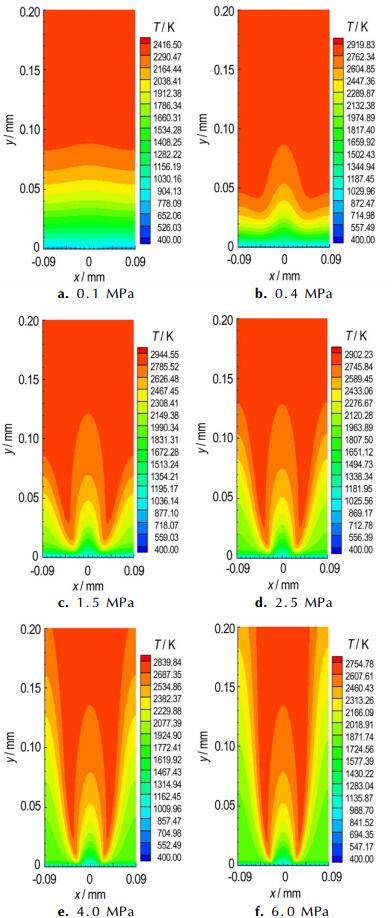
|
图 2 不同压力下的气相火焰温度分布 Fig.2 Gas phase flame temperature distribution at different pressure |
氧化剂AP体积分数为0.75时, 不同压力下的容积释放速率分布如图 4所示, 总体来看, 气相火焰热释放速率随压力升高而递增, 火焰对燃面的热反馈随压力增大而加强。压力较低 ( < 0.4 MPa, 图 4a) 时, 预混火焰热释放区域为一个整体, 纵向分布较大, 容积放热速率较小, 在AP燃面上方各有一个较大的放热核心, 随着压力升高, 火焰热释放区域轴向缩减变窄, 面积减小, 两个放热核心收缩且逐渐分离, 火焰由一个整体逐渐分裂形成两个扩散火焰带, 并且压力越高, 火焰放热核心越贴近燃烧表面。
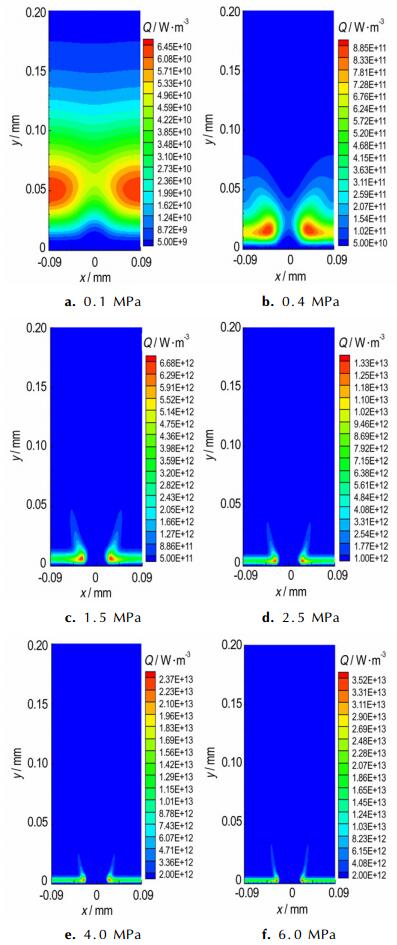
|
图 4 不同压力下的容积放热速率分布 Fig.4 Volume heat release rate distribution at different pressure |
图 5为不同压力下燃面各处的温度分布。由图 5可以看出, 随着压力增大, 氧化剂AP燃面温度比粘结剂燃面温度低, 燃面各处温度升高, 但HTPB燃面最高温度变化幅度大于AP燃面处的温度增幅, 燃面最高温度位置处于粘结剂一侧。由于燃面退移速率与温度成正相关, 可推断出不同压力下燃面各处的燃速, 如图 6所示, 燃速整体随着压力升高而增大, 但AP燃速随压力变化增幅更大, 所以压力较低时, HTPB燃速高于AP燃速, 压力较高时, HTPB燃速反而低于AP燃速。图 7为Price[1]扫描电镜观测到的低压和高压下的燃面轮廓, 可知低压下AP相对HTPB凸起, 高压下AP相对于HTPB凹陷, 计算结果与该实验相吻合。
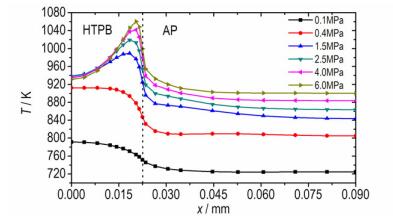
|
图 5 不同压力下的燃面温度分布 Fig.5 Temperature distribution of the burning surface at different pressure |
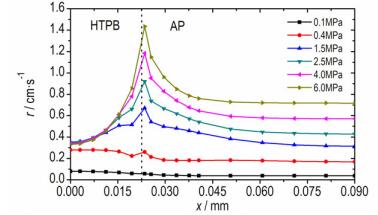
|
图 6 不同压力下的燃面燃速分布 Fig.6 Burning rate distribution of the burning surface at different pressure |
当燃烧压力不变时, 以2.5 MPa为例, 不同氧化剂AP体积分数下的容积放热速率云图, 如图 8所示。可以看出, AP体积分数为0.7~0.95时, 随着AP含量增大, 则粘结剂相对越窄, 容积放热速率越小, 气相热释放区域由两个合并连接形成一个整体, AP/HTPB交界处上方的火焰带逐渐变短消失。图 9为AP高体积分数和低体积分数下的火焰温度分布云图, 结合图 8可知, α=0.7时, 气相火焰热释放最大, 此时微观单元火焰呈现出富燃特性, 有两个狭长带状火焰面, 最大容积放热速率为2.54×1013 W·m-3, 燃烧火焰最高温度为3376 K, 随着氧化剂AP体积分数增大, α=0.95时, 气相热释放区域为一个整体, 热释放量最小, 火焰单元呈贫燃特性, 此时最大容积放热速率为7.53×1012 W·m-3, 燃烧火焰最高温度降低为2085 K。可见, 随着氧化剂AP体积分数增大, 容积放热速率减小, 气相对固相燃面的热反馈降低, 导致燃面温度衰减, 燃速降低。
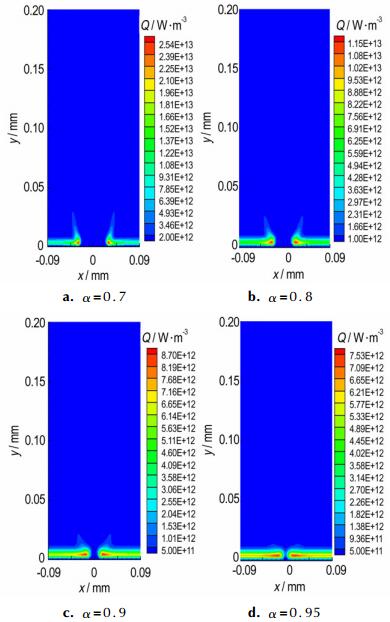
|
图 8 不同AP体积分数下的体积热释放速率分布 Fig.8 Volume heat release rate distribution under the different volume fraction of AP |
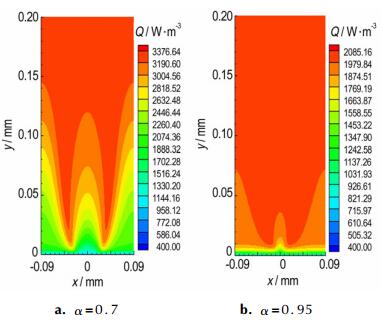
|
图 9 不同AP体积分数下的气相火焰温度分布 Fig.9 Gas phase flame temperature distribution under the different volume fraction of AP |
建立了AP/HTPB微观单元的二维周期性三明治定常燃烧模型, 对不同压力和不同氧化剂含量下的扩散燃烧过程进行了数值模拟, 可得如下结论:
(1) AP体积分数为0.75, 燃烧压力小于0.4 MPa时, 燃烧火焰呈预混燃烧特性, 随着压力升高, 为0.4~2.5 MPa时, 火焰呈预混-扩散双重燃烧特性, 压力大于2.5 MPa时, 燃烧火焰结构发展为扩散结构。
(2) 当AP体积分数为0.75, 燃烧压力为0.1~6.0 MPa时, 压力越大, 气相燃烧热释放及其对固相的热反馈越强, 燃面的温度越高, 对颗粒燃烧速度起更大的推进作用, 但AP燃速随压力变化更大, 故低压下AP相对HTPB凸起, 高压下AP相对于HTPB凹陷。
(3) 当压力不变时, 即在2.5 MPa下, AP体积分数为0.7~0.95时, 随着AP含量增大, 粘结剂相对越窄, 气相放热量变小, 火焰温度降低, 两个分裂的独立放热区域逐渐合并形成一个整体, 且在AP/HTPB交界处上方的两个狭长带状火焰面逐渐消失。
| [1] | Price E W, Sambamurthi J K, Sigman R K, et al. Combustion of ammonium perchlorate-polymer sandwiches[J]. Combustion and Flame, 1986, 63(3): 381-413. DOI:10.1016/0010-2180(86)90007-6 |
| [2] | Chorpening B T, Brewster M Q. Flame structure and burning rate of ammonium perchlorate/hydroxyl-terminated polybutadiene[J]. Proceedings of the Combustion Institute, 2000, 28(1): 847-853. DOI:10.1016/S0082-0784(00)80289-1 |
| [3] | Beckstead M W, Derr R L, Price C F. A model of composite solid-propellant combustion based on multiple flames[J]. Journal of AIAA, 1970, 8(12): 2200-2207. DOI:10.2514/3.6087 |
| [4] | Bilger W R, Jia X. The burke-schumann diffusion flame with zero net flux boundary condition[J]. Combustion Science and Technology, 1994, 99(4): 371-376. |
| [5] | Buckmaster J, Jackson T L, Yao J. An elementary discussion of propellant flame geometry[J]. Combustion and Flame, 1999, 117(3): 541-552. DOI:10.1016/S0010-2180(98)00116-3 |
| [6] | Jackson T L, Buckmaster J. Nonpremixed periodic flames supported by heterogeneous propellants[J]. Journal of Propulsion and Powder, 2000, 16(3): 498-504. DOI:10.2514/2.5596 |
| [7] | Hegab A, Jackson T L, Buckmaster J, et al. Nonsteady burning of periodic sandwich propellants with complete coupling between the solid and gas phases[J]. Combustion and Flame, 2001, 125(1): 1055-1070. |
| [8] | Cai W, Thakre P, Yang V. A model of AP/HTPB composite propellant combustion in rocket-motor environments[J]. Combustion Science and Technology, 2008, 180(12): 2143-2169. DOI:10.1080/00102200802414915 |
| [9] | Jackson T L. Modeling of heterogeneous propellant combustion: a survey[J]. Journal of AIAA, 2012, 50(5): 993-1006. DOI:10.2514/1.J051585 |
| [10] |
叶锐, 余永刚, 曹永杰. AP/HTPB二维火焰结构和燃速数值分析[J].
工程热物理学报, 2013, 34(3): 576-580. YE Rui, YU Yong-gang, CAO Yong-jie. Numerical analysis of flame structure and burning rate of two dimensional AP/HTPB sandwich combustion[J]. Journal of Engineering Thermophysics, 2013, 34(3): 576-580. |
| [11] |
曹永杰, 余永刚, 叶锐. AP/HTPB复合推进剂微尺度燃烧模型及数值分析[J].
推进技术, 2013, 34(11): 1567-1574. CAO Yong-jie, YU Yong-gang, YE Rui. A microscale combustion model and numerical analysis of AP/HTPB composite propellant[J]. Journal of Propulsion Technology, 2013, 34(11): 1567-1574. |
| [12] | Jackson L T, Buckmaster J. Heterogeneous propellant combustion[J]. Journal of AIAA, 2002, 40(6): 1122-1130. DOI:10.2514/2.1761 |
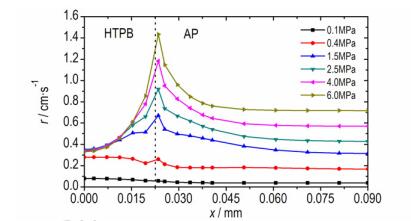
A 2D steady state combustion model for microscopic flame structure and burning characteristics of AP/HTPB composite solid propellant was established. The sandwich structure was adopted in the model, including the coupling between gas-phase flame and solid-phase propellant.





